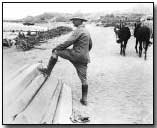Battles - The Turkish Attack at Anzac Cove, 1915
 Although the focus of
activity on the
Gallipoli peninsular in the wake of the
Allied landings
of 25 April 1915 had been at Helles - including two failed attacks upon
the village of Krithia and its nearby prominent hill feature Achi Baba in
April and
early May - the
Turk defenders at Anzac Cove launched a concerted attack on 19 May 1915.
Although the focus of
activity on the
Gallipoli peninsular in the wake of the
Allied landings
of 25 April 1915 had been at Helles - including two failed attacks upon
the village of Krithia and its nearby prominent hill feature Achi Baba in
April and
early May - the
Turk defenders at Anzac Cove launched a concerted attack on 19 May 1915.
The attack was simplistic in its intention - to drive the Australian and New Zealand troops (Anzac) stationed at Anzac Cove back into the sea.
This was not in itself as ambitious a plan as it may have appeared. The distance from the Allied front line and the reserve beaches was short enough that troops taken out of the line and sent into rest remained under heavy fire. Nor did the Allied trenches provide much in the way of effective cover from artillery and machine gun fire. Soldiers would attempt to burrow pockets into trench walls as a means of affording at least some protection.
Aside from the ever-present risk of sudden death or maiming, trench conditions grew increasingly unsanitary as the corpses of men and animals remained uncollected and unburied in No Man's Land. Disease rose accordingly. In the midst of these conditions the Turk defenders unleashed a remarkable attack upon the centre of the Allied line in the darkness of the early hours of 19 May.
Unfortunately for the Turks - and most fortuitously for the Anzacs stationed under William Birdwood - troop build-up in the Turkish lines was noticed by Allied observers. Thus when the attack began - some 42,000 Turks pitted against 17,000 defenders - Australian and New Zealand troops were in position to cut down the Turks who advanced in successive waves across open ground.
 Disastrously
for the Turks the decision to continue sending men
over the top resulted in
some 10,000 casualties over the course of six hours, with at least 3,000
lying dead between the lines, from small arms and machine gun fire without
the least prospect of success against the well-prepared Anzacs.
Disastrously
for the Turks the decision to continue sending men
over the top resulted in
some 10,000 casualties over the course of six hours, with at least 3,000
lying dead between the lines, from small arms and machine gun fire without
the least prospect of success against the well-prepared Anzacs.
Yet the motive behind the Turkish attack was clear. By breaking through the second ridge to the right of the Allied line, where No Man's Land was as short as 15 yards, a very real opportunity presented itself to achieve a breakthrough and dismiss the Allied force from Anzac Cove.
Five days later, on 24 May, a temporary truce was agreed in order that the Turks could collect and bury their dead from No Man's Land. The sector returned to relative peace for much of the following three months as the Turks reconsolidated in shock. During their defence the Australians and New Zealanders suffered just 160 fatalities and 468 wounded.
To view maps detailing the progress of the Gallipoli campaign click here; and here; and here; and here.
Photograph courtesy of Photos of the Great War website
A "Grand Slam" was British slang for an impending attack or battle.
- Did you know?
